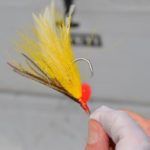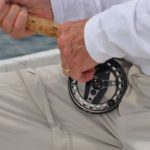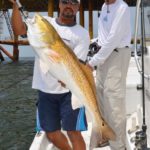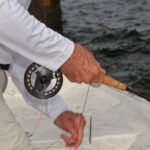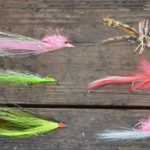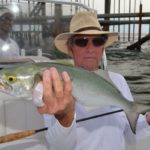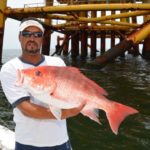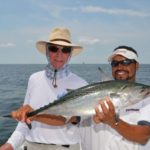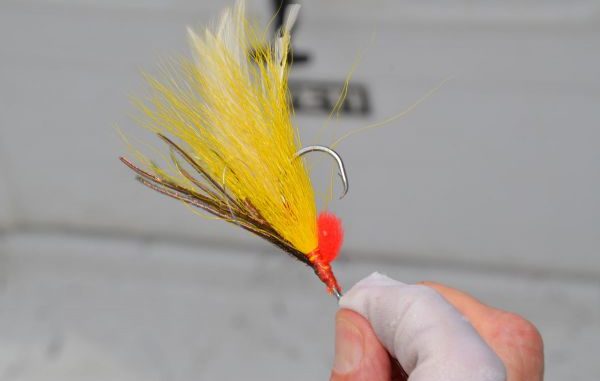
For fly fishermen, the spice of life is variety. And there are few placed holding more diversity of fish life than the nearshore rigs. Learn how this Baton Rouge fly fisherman takes advantage of those opportunities.
On the ride to Golden Meadow, I scratched my head and rubbed my chin. I didn’t know what I had let myself in for.
Fly fishing in the Gulf?
And I didn’t know either of the people I was going to spend the day on the water with.
The guide, Chad Billiot, carried the nickname “Marsh Rat.” There had to be a story in that by itself.
My fisherman, Roger del Rio of Baton Rouge, I knew only by reputation. He was supposed to be a hot-shot fly guy.
I got to the meeting point early and found a fair-skinned, lithe man fiddling with a fly rod.
“That’s got to be my man,” I thought.
When I shook hands with him, I immediately noticed he had the hands and fingers of a piano player.
The well-spoken 70-year-old explained what this gig was all about.
“I instigated this trip for a story to introduce people to a whole new world — fly fishing nearshore rigs in the Gulf of Mexico,” del Rio said. “The challenge for most fly fishermen is to catch as many different kinds of fish on a fly rod as possible. Close-in offshore rigs hold a wide variety of fish.
“This kind of trip is more about the challenge of catching fish than it is catching fish to eat. Fly fishermen don’t have to come in with a limit of fish, although I do retain some of my catch for consumption.”
Del Rio, it turns out, is one of the founding members of the Red Stick Fly Fishing Club in Baton Rouge, one of the largest outdoorsmen’s clubs in Louisiana.
He wasn’t always a fly guy, though. He was an avid speckled trout fisherman for years and had a camp in Cocodrie. Before that, he was a bass fisherman.
Then, in 1987 he watched a television show with famed fly fisherman and fishing artist Dave Whitlock.
Whitlock explained lines, rods, reels and flies. But at that time hardly any fly fishing equipment was sold in Baton Rouge.
He found some line at a Wal-Mart, picked up a rod in New Orleans and started practicing.
From the late 1980s until 2010, he wouldn’t touch any other kind of rod. Then he eased up and began sometimes using spinning tackle because he wanted to “catch bigger trout — up my production.”
Humorously, several of the members of the club he helped found now actively castigate him for fishing with spinning tackle.
“It becomes an addiction,” he said of fly fishing. “It’s like a disease. In the club, we have some guys who would rather tie flies than fish. Others would rather build rods than fish. Some want to fish every chance. Some just want to hang out and talk.
“Fishing with a fly rod is challenging; it’s hard to catch fish on a fly.”
Del Rio’s soliloquy was interrupted when Billiot, our guide, rolled up towing his 24-foot Blazer Bay.
“Are you ready?” he asked unnecessarily. “Follow me. We’ll launch at the public boat launch at Fourchon. I want to fish the Bay Marchand (oil) field in South Timbalier today.”
On the short cruise offshore, I got a good look at my two partners in crime. They seemed opposite in every way.
Billiot was a whole generation younger than del Rio. He was swarthy and dashing, while del Rio’s skin complexion was almost porcelain-like and would need protection from the sun before the day is out.
Del Rio was reserved, almost quiet; Billiot was a chatterbox.
As Billiot piloted his boat out of the pass, he explained that they would start west of the pass and work their way eastward, focusing on small satellite platforms (those typically holding one well) in the 40- to 50-feet depths.
The deepest rig the pair fished during the day was in 62 feet of water.
Billiot peered upward and grimaced.
“I want more sun than we have now. The sun actually brings fish to the surface,” he said. “Fly fishing is all about sight. I want to be able to see 10 feet down the legs of a platform.”
While the boat was running, Billiot rigged a heavy spinning rod with a 1 ¼-ounce Bass Assassin jig and a 7-inch paddle-tail Bass Assassin grub.
“This will bring fish to the surface because other fish will follow hooked fish, and then Roger can cast to them,” Billiot said. “It really works with cobia.”
It was obviously not this experienced captain’s first rodeo guiding fly fishermen.
His proficiency also showed in his skill at maneuvering the big boat to hold it near enough to each platform for del Rio to spot fish and properly present his fly.
Making it even more challenging was the rocking and rolling of the boat caused by the remains of a late-season cold front.
Del Rio was either standing spread-eagle or staggering while trying to strip line to give the fly some action.
Stripping involves snugging the line to the rod handle with the forefinger of his rod-holding hand and pulling the line in with rapid strokes of the other hand, allowing the retrieved line to fall to the deck.
Del Rio’s first catch was a toothy, hard-fighting bluefish. After he unhooked and released the fish, he explained that fly tackle is classified using numbers from 1 to 14.
“With No. 1 you can cast ant-sized flies to freshwater trout,” he said. “No. 4 works for bluegills and No. 6 for bass. Typically, for (speckled) trout and redfish, I use No. 8 tackle. Out here, for coastal fishing like today, I use No. 10.
“It’s all based on line weight. They weigh the first 30 feet of line in grams. The bigger the line, the more the line weighs and the bigger the fly that can be thrown.”
Del Rio had to work hard for his fish. The overcast sky made sighting targets challenging, and the bouncing of the boat made proper fly presentation difficult.
Still, he caught fish. Billiot was ever ready with his landing net to scoop up the grab bag of species del Rio caught.
Part of the hard work on del Rio’s part was the vigorous stripping he had to do to move the fly.
“Fish out here hit a fast-moving bait,” he explained. “It’s a lot different than in the marsh.”
Now I understood why he wore a sleeve on his forefinger to protect it from the line.
Most of del Rio’s fishing was done with a 9-foot rod that held sinking fly line, although he had a second rod that held floating line.
“I am using a sinking line,” he said, “to get the bait down to the fish, but I highly recommend a floating line for cobia.
“Sometimes they just won’t follow the fly down.”
Attached loop-to-loop to the fly line was a 20-pound-test fluorocarbon tippit. Between the tippit and the hook, del Rio used a 12-inch, 50-pound-test shock leader to help deal with fish teeth.
The shock leader was attached to the tippit with a variation of an Albright knot.
Del Rio stored his flies pre-tied on tippits and shock leaders in zipper-type plastic bags marked as to their contents. Doing so minimizes knot-tying on the boat.
His flies were mostly Clouser-type streamers. The hook shanks were wrapped with chenille to make the body, and the flies’ fins or wings made with bucktail that also serves to keep the hook upright.
The flies’ eyes were made of lead to provide ballast that also helps to keep the hooks upright.
Billiot’s trained eyes spotted several jack crevalles.
“I’ve never caught one of those,” del Rio said, excitement creeping into his voice.
Billiot demonstrated his boat-handling skills by perfectly positioning the craft, and del Rio did his part with a flawless fly presentation.
He quickly set the hook — like fly fishermen do — using a strip set, a hard retrieve of the line with the non-rod holding hand.
The hooked fish quickly began to take line that had been coiled at del Rio’s feet.
“I’ve got to get him on the reel without giving him too much slack,” he grunted.
Getting a fish on the reel means using the reel like a conventional level-wind reel to fight the fish rather than by stripping line in by hand as is done for smaller fish.
Del Rio soon found out he was hooked to an unbreakable bull of a fish. The fish wouldn’t give up, and del Rio wouldn’t give up.
Billiot asked if he wanted to break the fish off. The angler shook his head and murmured that he wanted to catch the fish.
An hour and 10 minutes later, the stalemate hadn’t changed. Del Rio held the reel in a mortal lock in his hands so the fish couldn’t take out any line. But he made zero headway in turning the fish toward the boat.
Billiot watched del Rio with a mixture of concern and amusement on his face. The angler’s head was bowed over, his eyes were closed and sweat dripped from his face.
“Are you OK?” he asked with some urgency.
Del Rio responded by nodding his head mutely.
After this mother of all battles, del Rio kept fishing and caught a few more fish, but the bloom was clearly off the rose.
After landing a spunky little hardtail, he threw in the towel.
“I’ve had enough,” del Rio announced.
He looked happy — tired, but happy.
